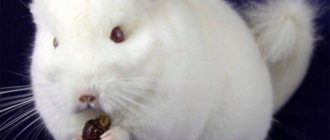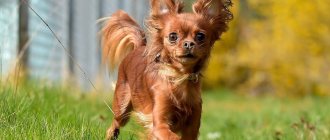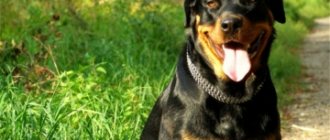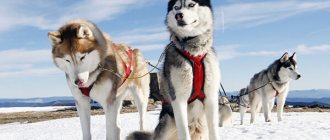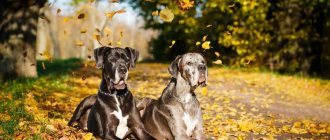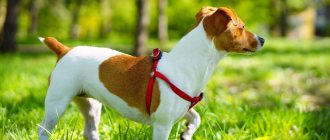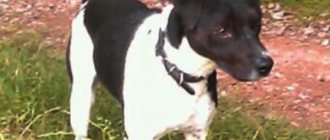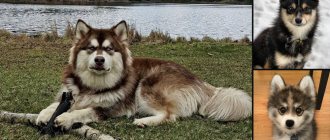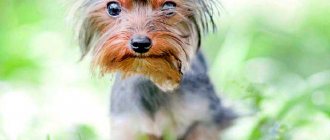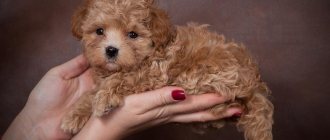Pugs combine many of the best qualities that can be found in dogs. Before you get a shaggy friend, evaluate your capabilities. To do this, it is enough to study the disadvantages and advantages of the breed.
There has always been a fashion for exotic dogs. Pugs are no exception. They are unlikely to pass for a guard dog, but they will be an excellent companion for you.
History of the pug breed
Pug
Although Pugs are visually somewhat reminiscent of English Bulldogs, Boxers and the now extinct Bullenbeissers from Germany, their origins are actually to be found in the East. Moreover, you will have to dig deep, because the first images of short-faced dogs that have survived to this day on ancient artifacts and mentions of them in historical documents date back to the 6th–4th centuries BC. The famous ancient Chinese philosopher and politician Confucius speaks of them as companions of the nobility traveling on chariots.
For a long time there was an opinion that another popular Chinese breed, the Pekingese, originated from pugs. However, genetic studies allow us to confidently say that family ties are built in the reverse order: long-haired dogs appeared much earlier, their direct ancestors were Lhasa Apso or Chemjo Apso, who guarded Tibetan monasteries, and pugs are either a cultivated natural mutation or the result of crossing with others short-haired breeds. Perhaps this is why Pekingese were considered exclusively imperial pets for centuries. But not everyone could afford to have pugs. This was the privilege of courtiers close to the ruler. The living conditions for the miniature dogs were truly royal, they ate much better than most ordinary subjects, often had their own chambers, servants for walking and personal security. For attempting to steal such a dog, severe punishment was imposed, including the death penalty.
Researchers suggest that the first European who had a chance to see the unusual pets of Chinese nobles was the Venetian merchant and traveler Marco Polo, who lived for seventeen years in a country exotic for a European. His “colleagues” from Holland and Portugal ended up in the Celestial Empire only two centuries later, during the era of the Great Geographical Discoveries. They brought home not only silk and spices, but also the charming Lo Chiang Tse, soon renamed to the easier-to-pronounce “pug.”
Pug puppy
The sturdy fawn-colored creatures with their sweet little faces and big eyes immediately attracted the attention of the aristocrats of the Old World. However, they played a special role in the fate of the Netherlands: the vigilance of the faithful Pompey helped William the Silent avoid death at the hands of an assassin at the height of the war for independence from Spain. Subsequently, the revolutionary leader of the Low Countries became the founder of the royal Orange dynasty, and the favorite accompanied the owner even after death - a sleeping dog was masterfully carved at the feet of the marble figure of the Dutch founding father on the lid of his sarcophagus. Pugs became a symbol and living mascot for William's heirs.
Through their efforts, the dogs came to Britain, where they quickly gained popularity among the local nobility, and subsequently dispersed to the royal courts of continental Europe. Queen Victoria, who doted on her pets, did especially much to revive interest in the breed among the British in the second half of the 19th century. Back then, “British” pugs were taller, leaner, with an elongated muzzle and had an exceptionally light color. But, as a result of the plunder of the Beijing Forbidden City during the Second Opium War by officers of the English and French armies, previously unknown black individuals came to the West. The latter are still quite rare and therefore more expensive. In general, pugs are an example of a breed whose popularity is fairly stable.
Nutrition
When organizing a diet for pugs, you need to choose natural or professional food. Mixed breed menus are not allowed.
It is convenient to purchase dry or wet ready-made food varieties that have a balanced composition. They allow you to calculate your daily consumption. It is important to always have clean water for your dog in a separate container.
If you prepare food yourself, then the main component is lean meat. Twice a week it is replaced with sea fish fillet. Additionally, vegetables, herbs, berries, fruits, fermented milk varieties, oatmeal, rice or buckwheat porridge are introduced. Vitamin and mineral supplements are prescribed for your pet by a veterinarian.
Puppies older than two months eat 4 times a day, after four months - three. Starting from six months, two meals a day are practiced. If necessary, on the advice of a doctor, adult dogs are fed only in the morning.
It is prohibited to include semolina and wheat groats, potato and bean dishes in your pet’s menu. Sweets, soy and corn, baked goods, smoked products, and sausage varieties are not used. Pasta, mushrooms, grapes, marinades, pickles, fried foods, and bones will harm your dog.
Puppies that receive a balanced diet grow quickly.
Dog weight by month:
| Age | Weight, kg |
| 1 | 0,65-1,15 |
| 2 | 1,5-2,25 |
| 3 | 2,15-3,4 |
| 4 | 3,45-4,7 |
| 5 | 3,65-5,9 |
| 6 | 4,15-7,1 |
| 10-12 | 6,5-9,0 |
Appearance of pugs
The ancient breed was recognized by international organizations of dog breeders at the end of the 19th century, and the official pug standard was approved only in 1987. Its main criteria are:
Weight and height
The normal weight range for an adult pug is 6.3 to 8.1 kg. The height in the standard is not clearly stated, but on average it is 25-30 cm for females and 30-33 cm for males.
General appearance
The Pug is a stocky dog with square outlines (the length of the body is equal to the height at the withers). The muscles are well developed, giving the impression of compactness and proportionality.
Color
Pugs have fawn (beige), apricot, silver or black colors. In the first three cases, a prerequisite is the clearest possible contrast between the main (light) color and the dark “mask” on the face and ears. The so-called “belt” is allowed - a dark strip of fur running along the spine from the occipital protuberance to the base of the tail, and the “diamond” - a dark spot on the forehead.
Black pug
Apricot pug
Wool
The pug's coat is short, fine, close-lying, smooth and soft to the touch. Usually has the same length throughout the body, but can be somewhat shorter on the muzzle and slightly longer in the rear of the body. Black animals have coarser coats than beige and apricot dogs.
Silver pug (white)
Fawn Pug (beige)
Head
A textbook example of a brachycephalic skull. Large, massive, rounded, but not “apple-shaped”, has no pronounced protrusions and dents, the bones of the skull are invisible. The muzzle is square, short, blunt, but not upturned, with deep symmetrical wrinkles. The forehead does not protrude above the brow ridges.
Eyes
Pug face
Dark (no whites should be visible), large, round, fairly convex, but not bulging. Set wide apart.
Nose
The bridge of the nose is small but pronounced, straight, with shortened rather than curved nasal passages. The nose is dark, in line with the eyes and visually is the center of the muzzle.
Jaws
The lower jaw is wide, the chin is well defined. For pugs, a tight overbite (no more than 3 mm) is the norm - the evenly spaced incisors of the lower jaw overlap the teeth of the upper jaw.
Neck
Strong, powerful, comb-shaped, slightly curved, length proportional to the body.
Ears
Pug ears are small in size in relation to the head, thin and very soft. Two forms are acceptable: laid forward, the internal openings of which are closed with the edges tightly pressed to the skull (“buttons”), or folded over the head, pulled back so that the inner part remains open (“roses”). First preference is given.
Torso
Short and massive, with a wide chest and well-defined, arched, set-back ribs. The topline is straight.
Forelegs
Strong, straight, of moderate length, well set under the body. The feet are neither overly elongated nor distinctly rounded, the toes are clearly separated and the nails are black.
Hind limbs
The pug's hind legs should be well developed, strong, straight, parallel to each other when viewed from behind, and of moderate length. The stifle and hock joints have clearly defined angles. The shape of the paws is elongated, but not long. The toes are well separated at the top.
Tail
The pug's tail is short, thick, densely covered with hair, set high and pressed close to the body. Twisted into a ring, with a double turn being preferred.
Movements
Springy, free, elegant, confident. The pug's gait is characterized by slight rolling movements.
Possible defects
- convex or “apple-shaped” skull;
- protruding forehead or hollows between the eyes;
- lack of bridge of nose;
- upturned or downturned nose;
- saggy jowls;
- disharmonious fold above the nose;
- lightened nose;
- narrow nostrils;
- close-set, light-colored, almond-shaped, slanted, too small, protruding or with the whites of the eyes showing;
- a twisted mouth exposing teeth and tongue;
- sagging or arched breasts;
- disproportionately long or short neck;
- long and/or fluffy coat;
- straightened joint angles.
Breeding
When purchasing purebred dogs for the purpose of reproducing offspring, you need to take into account the characteristics of pugs. The suitable reproductive period for a female is 1.5-6 years, and for a male 2-7 years.
Before crossing, pugs are shown to a veterinarian, undergo the necessary tests, and undergo routine vaccination. For mating, which it is advisable for a female to allow after two heats, the territory of a boy is preferable.
A dog's pregnancy lasts 2 months. During this period, provide fortified food for pugs at least three times a day. If toxicosis appears approximately in the middle of the cycle, foods to which the dog does not experience negative consequences are introduced into the breed’s diet. They often walk with their pet in the fresh air.
To competently deliver a dog, a veterinarian is invited. The female usually brings from 2 to 7 cubs.
Photo of an adult pug
List of suitable nicknames
Representatives of a unique breed with a long history of formation need to select appropriate names. They take into account the size, appearance, character, and temperament of the pet.
The veneration of these dogs with aristocratic origins by famous people plays a role. Names for pets in which growling consonants predominate are not recommended.
Popular nicknames for male dogs:
- Adonis, Adam, Aslan;
- Boniface, Balu;
- Viking, Knight, Vulcan;
- Joseph, Zephyr, Claude;
- Leo, Leslie, Lucky;
- Milan, Midas;
- Neil, Nils;
- Opal, Pluto, Pegasus;
- Stephen, Titan, Ulan, Phoenix, Fidel;
- Khan, Shah, Sheikh;
- Edgar, Emil, Eliot;
- Eustace, Yukon.
For girls:
- Agata, Alicia;
- Bagheera, Wanda, Viola, Vika, Vlada;
- Dona, Dina, Daisy, Jessica, Dominica;
- Zhanetta, Zlata, Zita;
- Jasmina, Josephine;
- Iolanta, Ivetta, Inessa, Iliad, Isabella, Inga;
- Lana, Liana, Louise, Lilia;
- Monica, Model;
- Naida, Nika;
- Lolita, Psyche, Roxana, Rose;
- Suzanne, Selena, Queen, Chara, Juno.
Pug character
As noted above, all pug owners describe them as friendly and sweet companions.
Puppies are quite playful, but as they grow older, the need for active leisure time fades away, and the main joy in a pet’s life becomes quiet hours on the couch in the company of its owner. Pugs are extremely attached to people, so it is not recommended to leave them alone for a long time, so as not to provoke stress. If you are planning a vacation or another trip, feel free to entrust your pet to the care of neighbors or friends - these dogs easily make contact even with strangers who show interest and good feelings in them. The love of the “little tank” is enough even for children, but it is worth keeping an eye on their communication, since during play they can, through carelessness, seriously injure the animal’s large and bulging eyes.
Unlike other decorative breeds, pugs are calm and balanced. They are not characterized by the “spoiled child” syndrome, which can often be encountered when interacting with “ladies’” dogs. If a pug wants your attention, he will simply come and sit next to you.
Pug owners will not have to listen to their neighbors' complaints about intrusive barking, which, of course, does not guarantee a regime of silence. Your pet will constantly snore loudly, wheeze and experience bouts of flatulence. Pugs are also the absolute champions of dog snoring, which you wouldn’t suspect given their modest size. However, many consider the latter to be more of a fun feature than a drawback.
Pug trainingDisqualifying faults
If the owner of a pug is planning for his pet to participate in exhibitions, it is important to know that there may be some features in their appearance that are disqualifying defects, and a purebred dog should not have them:
- apple-shaped skull;
- strongly prominent frontal bone, similar to that of the Japanese Chin;
- the bridge of the nose is poorly visible or absent;
- the nasal fold is asymmetrical;
- light-colored lobe;
- eyes - too protruding, light, small, slanted or almond-shaped;
- a distorted oral cavity, due to which the tongue protrudes or the teeth are severely exposed;
- arched chest shape;
- the neck is too short or, conversely, excessively long.
A culling breed is considered to be a long-haired or hairy, shaggy pug with a fluffy coat.
An atypical coat color is considered a cull.
Care and maintenance
Oh, watermelon!
Caring for a pug will not require extra effort from the owner. The short and smooth coat does not require professional grooming; it is enough to comb it at home. During the molting period, which happens twice a year, it is recommended to do this daily, and the rest of the time - less often. By the way, the future owner should know that pugs shed surprisingly profusely and be prepared for frequent cleanings. But experts advise bathing your pet as rarely as possible so as not to disturb the natural protective barrier on its skin. The best option is bathing procedures once a month.
Folds and wrinkles on the face require constant and close attention. They must be regularly and thoroughly cleaned of food particles and debris that gets there while being outside. This will avoid inflammatory processes and infections.
The duration of daily walks depends on their intensity. A leisurely walk can take up to an hour and a half, but a light jog should not exceed 10-15 minutes, since your pet's respiratory system is not designed for marathon races. In addition, it is imperative to take into account the temperature and humidity of the air - for a pug, hypothermia or overheating can, without exaggeration, become fatal. Short hair without a thick undercoat does not protect it from low temperatures, so during the cold season it is important not to forget about special clothing. The structural features of the muzzle do not allow excess heat to be effectively removed, and even with an increase in body temperature by 3-4 ºС, your pet may die. Therefore, in the summer it must be kept in an air-conditioned room.
Running pug
Basic moments
- One of the best breeds for keeping in the city and in an apartment
- Suitable for people with different lifestyles
- Loves children
- Gets along with other pets
- The pug breed is easy to care for, but monitoring nutrition and health takes a lot of time, effort and money
- Not aggressive
- Loves everyone: owner, family members, children, strangers, animals
- Suitable as a first dog
- Does not require intense physical activity
- The pug is smart, but due to its stubbornness it is difficult to train
- Cannot tolerate heat and cold
- Due to the brachycephalic shape of the head, problems with the respiratory and cardiovascular systems are common.
- The pug hardly barks, but makes many other sounds: whistling, snoring, grunting, muttering
- Prone to obesity and allergies
- May be jealous of owner towards other people and animals
- Can't stand loneliness
- In the 18th century in France, pugs were called carlens: for the black mask on their face, similar to the one worn by the hero of the comedy “Harlequin of Karlen”
- In 2004, a representative of the breed received the title of best dog at the World Dog Show.
Pug Health and Diseases
Unfortunately, we have to admit that pugs are far from the healthiest dogs. Throughout their lives, they have to deal with both congenital and acquired diseases. The most serious of the first category are encephalitis, the cause of which has not yet been fully elucidated by veterinarians, and epilepsy.
The most vulnerable places in the body of representatives of this breed are the eyes and respiratory system. Many pets become partially or completely blind as a result of mechanical damage, infections and other diseases. Cases of seasonal or chronic allergies are common. But the most common problem of this breed is undoubtedly obesity due to excessive appetite and low physical activity. It is not fatal in itself, but it shortens life expectancy, exacerbating existing health problems.
Interesting Facts
The secret “Order of the Pug” as depicted by artists
The Masons loved the breed so much that they founded the secret “Order of the Pug,” whose members wore silver pendants in the shape of a pug, so they covered up their forbidden gatherings under the guise of meetings of dog breeders.
There are many more fun and interesting facts known about pugs:
- This is the largest dog among all decorative breeds.
- In the 17th century, pugs were used for guarding and also in searching for missing people.
- These pets can snore louder than humans.
- They can run at a speed of no more than 3.5 km/h.
The pug is the most popular decorative breed. They love her for her sweet appearance, kind character, and quick wit. Keeping a pet is easy. But you will have to face one difficulty - pugs, who are prone to obesity, know how to delicately beg for their favorite treats, and it is very difficult to refuse them, looking into those big eyes.
How to choose a puppy
The main advice when choosing a pug is not new: contact kennels with an excellent reputation or experienced breeders, because animals purchased second-hand or through private advertisements may have not only external or disqualifying defects, but also significant health problems.
Before buying a pug, carefully study the pedigree of the parents, look at the living conditions of the animals, and get to know the puppy. A healthy baby, in addition to a correctly formed skeleton, standard color and the characteristics described in the breed standard, must have a lively, friendly disposition, not be afraid of people and not show aggression, and not be apathetic.
Preparing a place for a pet
The pug's sleeping place should be in a cozy corner. Do not place the bedding in a draft, near a radiator or on a walkway. Placing a puppy in a closet or storage room is strictly prohibited. Under no circumstances should you isolate your baby. It is also important to designate a place in the kitchen where the dog will eat. It is best to purchase special bowls on a tripod for these purposes. For leisure, a pug can use both a standard bedding and a small cozy house, which can be purchased at a pet store.
The pug's sleeping place should not be in a draft
If there are children in the house, it is important to prepare them for the dog's arrival. It is necessary to explain that a pet is a living creature that should not be disturbed from resting.
What to buy in advance
What you will need to keep a pet of this breed in an apartment:
- bedding - approximately 50x50 cm, dark shades of fabric are recommended;
- covers for bedding (preferably);
- collar;
- leash;
- waterproof diapers and diapers for dogs (for the period of puppy growth);
- 2 bowls (for water and food);
- tripods for bowls (optional);
- special shampoo;
- nail clippers;
- wet wipes (hypoallergenic);
- furminator;
- clothes for winter (dogs do not tolerate frost well);
- tray (if you plan to not walk the dog often);
- hypoallergenic soap (preferably laundry soap);
- chlorhexidine;
- rubber toys;
- specialized food.
Waterproof diapers - essentials for a small puppy
It is important to understand that the puppy will cause a lot of trouble at first. You need to be patient and prepare for the fact that your baby will need care and constant attention.
Photos of pug puppies
Feeding
Another advantage is the ability to feed your pug a variety of foods. Dogs equally love both natural food and dry food.
To keep your pet healthy and cheerful, do not skimp on its nutrition.
If the dog’s main diet is natural food, then try to supplement the menu with fresh meat, vegetables, cereals and bread. Try to give your dog raw meat, as it is quite nutritious and contains many useful substances.
Photo gallery
Look into those kind eyes, how they can hurt someone. These dogs are able to add a positive mood even on cloudy days by playing with their household members.
